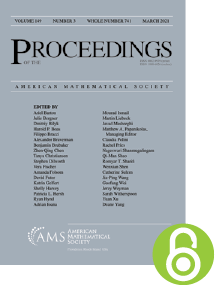Proceedings of the American Mathematical Society
Published by the American Mathematical Society since 1950, Proceedings of the American Mathematical Society is devoted to shorter research articles in all areas of pure and applied mathematics.
ISSN 1088-6826 (online) ISSN 0002-9939
(print)
The 2020 MCQ for Proceedings of the American Mathematical Society is 0.85.
What is MCQ? The Mathematical Citation Quotient (MCQ) measures journal impact by looking at citations over a five-year period.
Subscribers to MathSciNet may click through for more detailed information.


